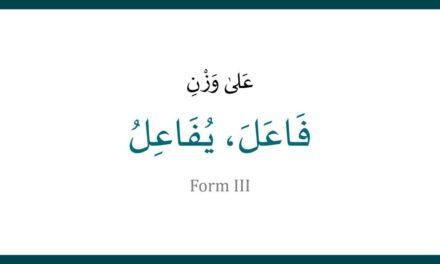
Meaning: The meaning of Form I verbs is not specific (understandable since other verb forms are derived from it to create another word with a related meaning).
- Form I is the fundamental verb form in Arabic as it is the barest form with no additional letters added to the root (مُجَرَّدٌ = bare, stripped)
- The vowel on the second root letter on a Form I verb varies in the past and present tense – it could be fatha, kasra or dhammah (see the table)
- The present tense can be predicted from the pattern of the past tense (and vice verse – see the table)
- If the second letter has a dhamma in the present tense, then the imperative has dhamma on the alif
- Form I verbs can be transitive or intransitive (usually it’s one or the other)
أَكَلَ المُعَلِّمُ خُبْزًا فِي الصَبَاحِ
The teacher ate bread in the morning
أَكَلَ المُعَلِّمُ فِي الصَبَاحِ
The teacher ate in the morning
- Form I can occasionally be doubly transitive (takes two objects)
- Verbs with the pattern فَعُلَ – يَفْعَلُ are always intransitive – the traits are ‘reflexive’
كَبُرَ الوَلَدُ
The boy grew up
- The meaning of this type of verb usually indicates one of the following :
- a state of being ( e.g. ثَقُلَ – to be heavy – ADJECTIVE: ثَقِيلٌ )
- the acquisition of something (e.g. كَبُرَ – to grow – ADJECTIVE: كَبِيرٌ)
- an increase of a certain quality (e.g حَسُنَ – to be good – ADJECTIVE: حَسَنٌ)
- Form I has many different verbal noun variations – one verb can have more than one verbal noun (usually one is used the most – the most commonly used verbal noun is the one indicated in the tables)
Strong Root Letters (صحيح)

*All the root letters are strong ‘صحِيح’
كَتَبَ= root: ك ت ب
شَرِبَ = root: ش ر ب
كََبُرَ= root: ك ب ر
Double Root Letters (مضاعف)
- When two root letters are the same and consecutive (double) it combines into one and a shaddah is put on the doubled letter.

دَلَّ= root: د ل ل = the 2nd and 3rd letters are the same
فَرَّ= root: ف ر ر = The 2nd and 3rd letters are the same
Hamza as a Root Letter (مَهْمُوز)
Words with HAMZAH (ء) as root letterh causes a few differences in the way the verb is conjugated.

أَكَلَ= root: أ ك ل – the first letter
Other VERBAL NOUNS of أَكَلَ include مَأكَلٌ، إِكْلَةٌ، أُكَالٌ، أَكَالٌ
They all share a similar meaning to أكْلٌ which is the most commonly used verbal noun out of the variations.
Weak Root Letters (مُعْتَل)
- If one of the root letters is a weak letter (ا / و / ي ), the pattern follows a similar pattern with a few differences. Notice the differences in the table.

وَضَعَ = root: و ض ع = the 1st letter is weak with a و
زَارَ = root: ز و ر = the 2nd letter is weak with a و
نَامَ= root: ن و م = the 2nd letter is weak with a و *notice how it doesn’t follow the exact same pattern as زَارَ
دَعَا = root: د ع و = the 3rd root letter is و

بَاعَ= root: ب ي ع = the 2nd letter is weak with a ي
بَنَى= root: ب ن ي= the 3rd letter is weak with a ي
نَسِيَ= root: ن س ي = the 3rd root letter is ي
رَأَى = root: ر أ ي = the 3rd root letter is ي

وَعِيَ= root:و ع ي = the 1st and 3rd letter is weak with و and ي
نَوَيَ= root: ن و ي= the 2nd and 3rd letter is weak with و and ي


![Theme: War and Conflict [A2 Vocabulary]](https://www.explorearabic.org/wp-content/uploads/2023/05/WP-Learning-lab-images-440x264.png)









![Theme: War and Conflict [A2 Vocabulary]](https://www.explorearabic.org/wp-content/uploads/2023/05/WP-Learning-lab-images-150x150.png)

